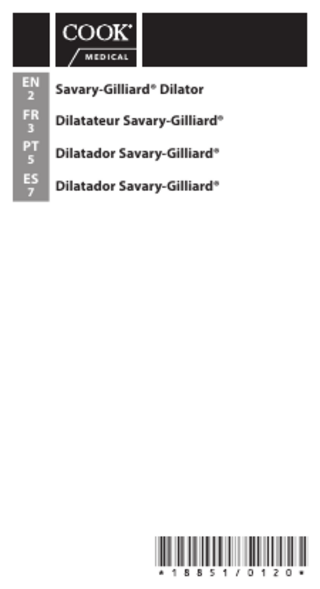COOK Inc
Savary-Gilliard Dilator SGD-x-xx Instructions for Use
12 Pages

Preview
Page 1
MEDICAL
EN 2
Savary-Gilliard® Dilator
FR 3
Dilatateur Savary-Gilliard®
PT 5
Dilatador Savary-Gilliard®
ES
Dilatador Savary-Gilliard®
7
60 cm 40 cm
80 cm
100 cm
120 cm
140 cm
1. ENGLISH INTENDED USE This device is used over a pre-positioned Savary-Gilliard wire guide for dilation of esophageal strictures. NOTES Do not use this device for any purpose other than stated intended use. Store in a dry location, away from temperature extremes. Use of this device restricted to a trained healthcare professional. CONTRAINDICATIONS Contraindications include those specific to upper GI endoscopy. Contraindications to dilation include, but are not limited to: uncooperative patient; asymptomatic strictures; inability to advance the dilator through the strictured area; coagulopathy; known or suspected perforation; severe inflammation or scarring near the dilation site, recent myocardial infarction, active ulcer and severe cervical arthritis. WARNINGS This device is supplied non-sterile and is reusable if the device integrity is intact. If the package is opened or damaged when received, do not use. Visually inspect with particular attention to kinks, bends and breaks. If an abnormality is detected that would prohibit proper working condition, do not use. Please notify Cook for return authorization. POTENTIAL COMPLICATIONS Potential complications associated with upper gastrointestinal endoscopy and esophageal dilation include, but are not limited to: perforation, hemorrhage, aspiration, fever, infection, allergic reaction to medication, hypotension, respiratory depression or arrest, cardiac arrhythmia or arrest. PRECAUTIONS Reusability of a device depends, in large part, on care of device by user. Factors involved in prolonging life of this device include, but are not limited to: thorough cleaning following instructions included in this booklet. INSTRUCTIONS FOR USE 1. Perform screening endoscopy to identify strictured area. 2.
Introduce a Savary-Gilliard Wire Guide, floppy tip first, into accessory channel of endoscope and advance until it is endoscopically visualized well beyond tip of scope.
3.
When wire guide is in position well beyond strictured area, slowly begin to withdraw endoscope in 5-10 cm increments while simultaneously advancing wire guide in 5-10 cm increments to ensure wire guide remains in position. Caution: Continuous fluoroscopic monitoring of wire guide is essential in order to ensure it remains in proper position. 2
4.
When endoscope is removed completely, fluoroscopically confirm that wire guide has not been displaced. Note: Markings on distal portion of wire guide may also be utilized to determine wire guide position. Markings occur in 20 cm increments from 40 to 140 cm. (See fig. 1)
5.
Generously lubricate dilator and advance it over pre-positioned wire guide to strictured area.
6.
Proceed with esophageal dilation. Note: Successive dilations can be accomplished by repeating steps 5-7.
7.
Upon completion of esophageal dilation, remove dilator and wire guide from patient.
8.
Clean and prepare dilator for future use following cleaning instructions below. During cleaning, inspect integrity and function of device to determine advisability of reuse. If kinks, bends or breaks exist, do not use. Dispose of device per institutional guidelines for biohazardous medical waste.
CLEANING INSTRUCTIONS Caution: Savary-Gilliard Dilators cannot be autoclaved or gas sterilized. Savary-Gilliard Dilator case should be washed thoroughly with soap and water then wiped dry with a lint-free cloth or air-dried. Note: Betadine is not recommended for use on Savary-Gilliard Dilators. 1.
Immediately after use, soak dilator in a solution of warm water and enzymatic cleaning solution. Note: Refer to enzymatic cleaning solution instructions for recommended duration of cleaning.
2.
Scrub external surfaces of dilator with warm water and enzymatic solution. Using a Savary Cleaning Brush (sold separately), brush wire guide lumen of dilator.
3.
Rinse dilator thoroughly with clean, running water. Attach suction to tapered end of dilator or utilize flushing adapter to suction water through wire guide lumen.
4.
Wipe external portions of dilator dry with a lint-free cloth. Use medical grade (oil-free) forced air to dry wire guide lumen of dilator.
5.
Proceed with high-level disinfection of dilator.
HIGH LEVEL DISINFECTION/STERILIZATION A list of disinfectant solutions for use with this device is as follows: • Glutaraldehyde • Ortho-phthalaldehyde (OPA) • Peracetic acid • Hydrogen peroxide 1.
Completely immerse dilator in a disinfectant. Note: Refer to disinfectant solution instructions for duration of immersion required for high level disinfection or sterilization. If difficulty is encountered with solution penetrating lumen, we recommend attaching suction to tapered end of dilator or utilize a flushing adaptor. Note: Discoloration of dilator may occur following use of these solutions. This is not harmful to device.
2.
Rinse dilator thoroughly with clean, running water, utilizing above method for thoroughly rinsing lumen. Attach suction to tapered end of dilator or utilize flushing adapter to suction water through wire guide lumen. Note: Proper rinsing with clean water and complete drying of dilator is necessary following use of these solutions.
3.
Dry external portions of dilator completely with a lint-free cloth. Use medical grade (oil-free) forced air to dry wire guide lumen.
FRANÇAIS UTILISATION Ce dispositif est utilisé sur un guide Savary-Gilliard prépositionné pour la dilatation de sténoses œsophagiennes. 3
Savary-Gilliard is a registered trademark of Bredam Medical Distribution SA.
Wilson-Cook Medical, Inc. 4900 Bethania Station Road Winston-Salem, North Carolina 27105 USA © 2020 Cook Medical